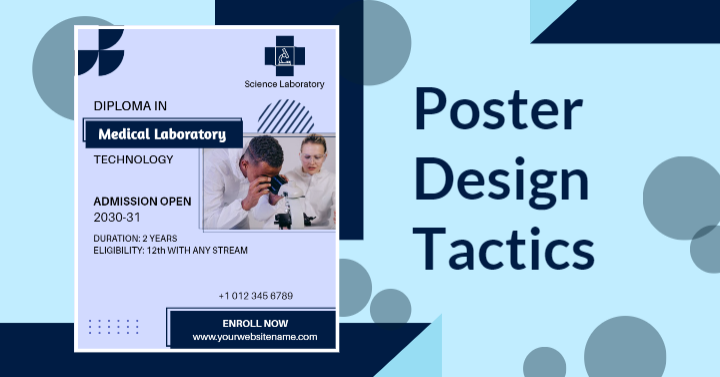Poster Design Tactics for Effective Visual Communication

Posters, with their vivid colors and compelling visuals, are powerful tools for communication. Whether promoting an event, conveying a message, or advertising a product, the effectiveness of a poster lies in its design. Unleash the potential of your communication strategy effortlessly and make a poster in minutes with a user-friendly poster maker. Elevate your brand and capture your audience. In this exploration, we’ll uncover the poster design tactics that make poster design an artful form of visual communication, catering to audiences of all ages.
The Art of Visual Storytelling: Poster Design Tactics
Posters have a unique ability to convey messages in a concise and impactful manner. Poster design is more than just arranging elements on a canvas; it’s an artful blend of creativity and communication. Let’s unravel the poster design tactics that contribute to effective visual storytelling through posters.
Know Your Audience: Designing for All Ages
Understanding the Viewers
A fundamental aspect of effective poster design is understanding the audience. Whether it’s children, teenagers, or adults, knowing your viewers’ preferences, interests, and expectations helps tailor the design to resonate with them. A poster for a school event might use playful colors and illustrations, while a corporate seminar poster would lean towards a more professional and sleek design.
Color Psychology: The Palette of Emotions
Choosing Colors Wisely
Colors are not just decorative elements; they evoke emotions and convey messages. Understanding color psychology is crucial in poster design. For instance, warm colors like red and orange can signify energy and excitement, while cool colors like blue and green may convey calmness and trust. The chosen color palette should align with the message and the emotional response you aim to evoke.
Typography Mastery: From Letters to Art
Crafting Captivating Text
Typography is an art form within itself. The fonts, sizes, and styles of text play a pivotal role in poster design. Choose fonts that align with the theme – elegant scripts for formal events, bold and playful fonts for children’s activities. Experiment with text hierarchy to guide the viewer’s attention and ensure that the text is easily readable from a distance.
Simplicity Reigns: Clarity in Design
Embracing Simplicity
In the world of poster design, less is often more. A cluttered poster overwhelms the viewer and dilutes the message. Embrace simplicity by focusing on essential elements. Use negative space strategically to allow the viewer’s eyes to rest and to highlight key information. A clear and uncluttered design ensures that the message is easily comprehensible.
Imagery Impact: Choosing the Right Visuals
Selecting Compelling Imagery
Images speak louder than words, and in poster design, the right visuals can make or break the impact. Choose images that align with the message and theme of the poster. High-quality, relevant visuals capture attention and convey the essence of the content. Whether it’s photographs, illustrations, or a combination of both, the imagery should complement the overall design.
Consistency is Key: Establishing a Visual Theme
Creating a Visual Theme
Consistency in design elements ties the poster together, creating a cohesive visual experience. Establish a visual theme by using consistent colors, fonts, and design elements throughout the poster. This creates a sense of unity and professionalism, making the poster visually appealing and easy to follow.
Contrast for Emphasis: Making Elements Pop
Playing with Contrast
Contrast is a powerful design tool that adds visual interest and emphasis. Play with contrast in colors, fonts, and sizes to make specific elements stand out. For instance, use a bold font against a light background or a vibrant color against a neutral backdrop. This draws attention to key information and guides the viewer’s focus.
Readability Matters: Fonts, Sizes, and Spacing
Prioritizing Readability
No matter how visually stunning a poster is, it fails its purpose if the content is not readable. Choose fonts that are easy to read from a distance, especially in event spaces or busy environments. Pay attention to font sizes, ensuring that essential information is prominent. Proper spacing between text and other elements enhances readability.
Grid System Precision: Structuring the Design
Harnessing the Grid System
Behind many aesthetically pleasing posters is a well-structured grid system. This invisible framework guides the placement of elements, ensuring balance and coherence. Whether it’s a simple one-column grid or a more complex layout, the grid system provides a structure that guides the eye and organizes information logically.
Call-to-Action Clarity: Guiding the Next Step
Crafting Compelling CTAs
Every effective poster should guide the viewer on what to do next. Whether it’s attending an event, making a purchase, or visiting a website, a clear Call-to-Action (CTA) is crucial. Craft compelling CTAs using action verbs and concise language. Make them visually prominent, ensuring that they stand out amidst other elements.
Engaging Imagery: Interactive Elements
Incorporating Interactive Elements
In the digital age, posters can go beyond static images. Consider incorporating interactive elements such as QR codes that lead to additional content, augmented reality features, or tear-off tabs with contact information. These interactive elements enhance engagement and provide additional avenues for communication.
Discover:
Top 5 Mistakes to Avoid While Designing a Logo
To Summarize
Effective poster design is a delicate balance of artistic expression and strategic communication. Whether it’s a school announcement, a concert poster, or a promotional advertisement, these poster design tactics and a digital poster maker serve as a guide to creating visually compelling posters that leave a lasting impact on your audience.




